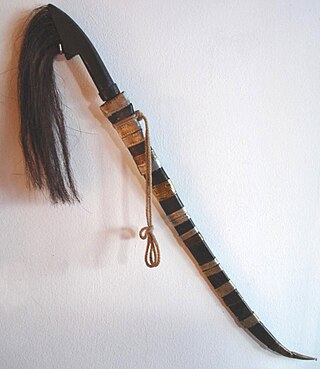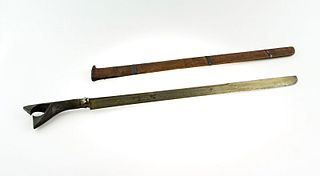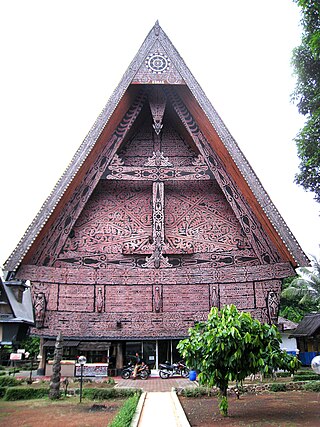
The karambit or kerambit, kurambik or karambiak is a small Indonesian curved knife resembling a claw from the Minangkabau people of West Sumatra. The karambit is one of the weapons commonly used in pencak silat and Indonesian martial arts.

The kris, or keris in the Indonesian languages, is an Indonesian asymmetrical dagger, both weapon and spiritual object, with distinctive blade-patterning achieved through alternating laminations of iron and nickelous iron (pamor). Of Javanese origin, the kris is famous for its distinctive wavy blade, although many have straight blades as well, and is one of the weapons commonly used in the pencak silat martial art, native to Indonesia.

The kampilan is a type of single-edged sword, traditionally used by various ethnic groups in the Philippine archipelago. It has a distinct profile, with the tapered blade being much broader and thinner at the point than at its base, sometimes with a protruding spikelet along the flat side of the tip. The design of the pommel varies between ethnic groups, but it usually depicts either a buaya (crocodile), a bakunawa, a kalaw (hornbill), or a kakatua (cockatoo)..

Batak is a collective term used to identify a number of closely related Austronesian ethnic groups predominantly found in North Sumatra, Indonesia, who speak Batak languages. The term is used to include the Karo, Pakpak, Simalungun, Toba, Angkola, and Mandailing ethnic groups. Which are related groups with distinct languages and traditional customs (adat).

Japanese sword mountings are the various housings and associated fittings that hold the blade of a Japanese sword when it is being worn or stored. Koshirae (拵え) refers to the ornate mountings of a Japanese sword used when the sword blade is being worn by its owner, whereas the shirasaya is a plain undecorated wooden mounting composed of a saya and tsuka that the sword blade is stored in when not being used.

The panabas, also known as nawi, is a large, curved sword used by certain ethnic groups in the southern Philippines. It can range in size from 2 to 4 feet and can be held with one or both hands, delivering a deep, meat cleaver-like cut. In its heyday, it was used as a combat weapon, as an execution tool, and as a display of power. Occasional use as an agricultural and butchering tool has also been noted.

The surik is a traditional sword native to the island of Timor or Nusa Tenggara in wider extent, as well as Sumatra. The first coat of arms of East Timor depicted crossed suriks.

Niabor is a curved sword from Borneo, a characteristic weapon of the Sea-Dayaks.

The Pandat is the war sword of the Dayak people of northwest Borneo and is never used as a tool. On October 18, 2016, this weapon was featured in season 3 episode 9 of the American bladesmithing competition series Forged in Fire.

Parang Nabur is a sword that originates from Banjarmasin, South Kalimantan, Indonesia. Most of these swords were made during the Banjarmasin Sultanate period in the 19th century.

Balato is a sword that originates from Nias, an island off the west coast of North Sumatra, Indonesia.

Sewar refers to a dagger of Indonesian origin, typically carried in a belt and used mainly in Sumatra, Indonesia. The blade is also referred to as Sewah by the Gayo people, Seiva by the Minangkabau people, Siva by the Alas people, and Siwaih by the Acehnese people.

Sikin Panjang is a sword originated from northern Sumatra, Indonesia.

Palitai is the traditional knife of the Mentawai people, originating from the Mentawai Islands off West Sumatra, Indonesia.

Wedung is a traditional large knife of the Javanese people and the Balinese people originating from Indonesia.

Gorga is a form of artistic decoration found in the culture of Batak Toba in North Sumatra, Indonesia. The gorga motif is in the shape of flourishes and undulations. The motif is either painted or carved onto wood using three colors: white, red, black; each corresponds with different realms in the Batak Toba cosmology. Gorga motif is often found in Batak Toba architecture e.g. a Batak Toba house or objects e.g. music instruments. They are meant to protect the building or object from spiritual harm e.g. evil spirits sent from neighboring village.

Pisau raut is a whittling knife that is commonly as a tool to prepare the rattan and other fine carving found throughout the entire Malay archipelago. It is well known as an accompanying knife placed in the same sheath with the mandau, a traditional weapon of the Dayak people.

A Rudus is a sword or cutlass associated with the Malay culture of Sumatra. Together with the pemandap, the rudus is among the largest swords of Malay people. Rudus is also a symbol of certain Malay state in the Island, e.g. the Province of Bengkulu in Sumatra, Indonesia.

The Piso Sanalenggam is a type of broad sabre from North Sumatra, Indonesia. This sword is a weapon of war during the times when feuds were frequent among the different Batak groups. Piso Sanalenggam that were made by datu priests from the Dairi Regency region, is used for the preparation of medicine and magical substances.

Tumbok Lada or Tumbuk Lada is a traditional slightly curved dagger that originates in the eastern coast of Sumatra, Indonesia but also found in the western coast of Malay Peninsula, Malaysia.























